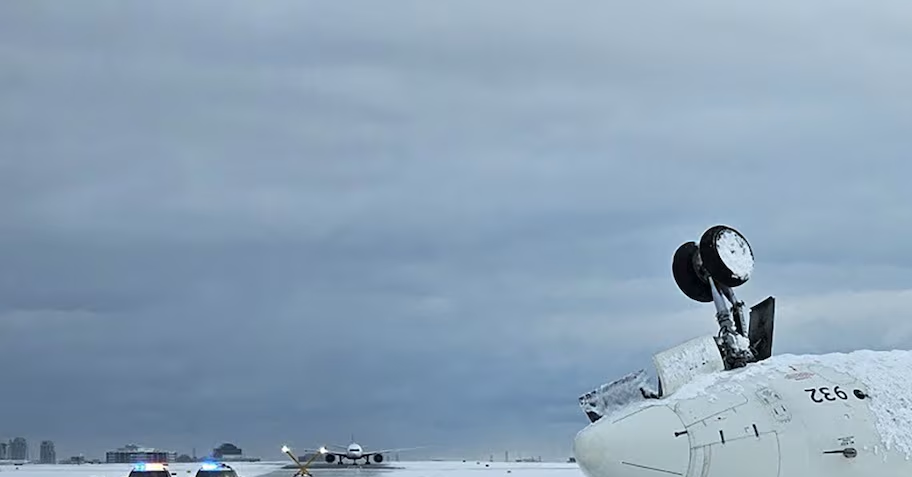Item 1 of 6 The wreckage of a Delta Air Lines operated CRJ-900 aircraft lies crashed on the runway at Toronto Pearson International Airport in Mississauga, Ontario, Canada February 18, 2025. TSB/Handout via REUTERS
[1/6]The wreckage of a Delta Air Lines operated CRJ-900 aircraft lies crashed on the runway at Toronto Pearson International Airport in Mississauga, Ontario, Canada February 18, 2025. TSB/Handout via REUTERS Purchase Licensing Rights
Feb 19 (Reuters) – Delta Air Lines (DAL.N)
, opens new tab CEO Ed Bastian said on Wednesday the pilots of the regional jet that flipped upside down upon landing in Toronto this week were experienced and familiar with flying in wintry conditions.
“There is one level of safety at Delta,” Bastian told “CBS Mornings” in an interview. “All these pilots train for these conditions.”
On Monday, the day of the crash, Toronto Pearson Airport was dealing with high winds and frigid temperatures as airlines attempted to rebound after a major weekend snowstorm.
Bastian called video of the accident, which injured 21 of the 80 people on board, “horrifying” but praised the actions of the flight crew to quickly evacuate the airplane.
“This is what we train for,” Bastian said. “We train for this continuously.”
Delta said on Wednesday only one of the 21 passengers remains hospitalized. All of the injured are expected to survive.
The plane was removed from its runway location on Wednesday evening, Delta said.
The airline said it was offering $30,000 goodwill payments to all passengers that would not impact their legal rights, including their ability to sue the carrier.
Transportation Safety Board of Canada said in a statement that investigators were conducting interviews and had downloaded data from the recovered black boxes that was being analyzed.
Two runways remain closed at Toronto’s Pearson Airport, including the busiest runway in the country, with the wreckage of the 16-year-old CRJ900 regional jet made by Canada’s Bombardier (BBDb.TO)
, opens new tab still on airport grounds.
Investigators will examine the runway before the site is cleaned up and released to the airport for a return to operations, TSB said.
The crash reduced capacity at Canada’s largest airport, which has a limit on departures for its three other operational runways, Toronto Pearson duty manager Jake Keating told news channel CP24.
Toronto Pearson said in a post on X that as of 7 a.m. ET (1200 GMT) on Wednesday, about 5% of its departing flights and 6% of its arriving flights have been canceled.
TSB senior investigator Ken Webster said that following initial impact on the runway, parts of the CRJ900 aircraft separated and a fire ensued.
In a video showing the plane’s descent, the landing appeared flat and did not show the regular “flare” of the jet, where pilots pull the nose up to increase pitch just prior to touchdown, experts said.
Webster echoed other aviation safety officials saying it was too early to tell what happened to Flight 4819 from Minneapolis-St. Paul. Air crashes are usually caused by multiple factors.
Bastian said despite several high-profile incidents, air travel remains safe. “It is the safest form of transportation, period,” he said.
The crash in Canada followed other recent crashes in North America. An Army helicopter collided with a CRJ-700 passenger jet in Washington, D.C., killing 67 people, while at least seven people died when a medical transport plane crashed in Philadelphia and 10 were killed in a passenger plane crash in Alaska.
Separately, Bastian said he had spoken to U.S. Transportation Secretary Sean Duffy and was not concerned by the layoff of several hundred employees at the Federal Aviation Administration, saying they were in “non-critical safety functions.”
Bastian said the Trump administration was committed to boosting air traffic controller hiring and improving air traffic technology.
Sign up here.
Reporting by David Shepardson in Washington and Allison Lampert in Montreal; Editing by Chizu Nomiyama, Marguerita Choy, Jamie Freed and Michael Perry
Our Standards: The Thomson Reuters Trust Principles.



